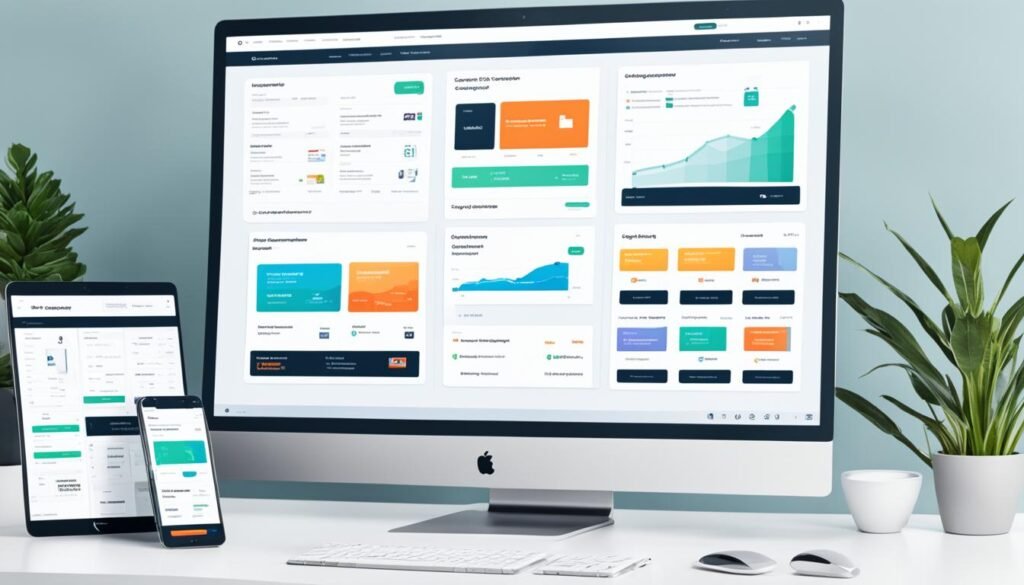Welcome to the world of online shopping in 2024! E-commerce stores are on the rise. We’re here to help you start your digital marketplace. Global e-commerce sales are expected to reach $6.3 trillion this year. This means it’s a great time to get started.
Starting an e-commerce store is more than selling online. It’s about creating a unique online place to shop. We will guide you from picking a business model to website creation. This guide will make your journey into online retail easy.
Are you ready to start your e-commerce journey? Let’s explore how to make your online business thrive in the digital world.
Understanding the E-commerce Landscape
The way we shop online is changing fast and will keep changing. Let’s take a look at what’s happening in online retail. We will cover trends, growth forecasts, and the hurdles and chances for online shops now.
Current trends in online shopping
Online shopping habits are transforming. More people buy things on their phones. Sellers customize the shopping experience. This makes shoppers feel like the site knows them. Buying through social media is becoming more common too.
Projected growth of e-commerce
The outlook for online shopping is promising. It’s estimated that global sales online will top $5 trillion by 2022. This will make up more than one-fifth of all sales. By 2025, that number could jump to over $7 trillion. As more people use the internet, more people buy online.
| Year | Global E-commerce Sales | Percentage of Total Retail Sales |
|---|---|---|
| 2022 | $5+ trillion | 20%+ |
| 2025 | $7+ trillion | 22%+ |
Key challenges and opportunities
Online shops have to stand out in a crowded market and keep data safe. Logistics can also be tricky. But there are chances in smaller markets and selling across borders. New tech, like AI and AR, can improve how customers shop, making one store better than another.
- Challenges: Intense competition, cybersecurity, logistics management
- Opportunities: Niche markets, cross-border e-commerce, AI and AR integration
“The e-commerce industry has seen significant evolution with the rise of companies like Amazon, Alibaba, eBay, and Etsy.”
Choosing Your E-commerce Business Model
Choosing the right business model is important in e-commerce. We will look into different models and delivery methods. This guidance will help you carve your space online.
B2C, B2B, C2C, and C2B Models
E-commerce has several models to meet various needs:
- B2C (Business-to-Consumer): Direct sales to individual customers
- B2B (Business-to-Business): Transactions between companies
- C2C (Consumer-to-Consumer): Peer-to-peer sales platforms
- C2B (Consumer-to-Business): Individuals offering services to businesses
Each model is special. For instance, B2B sales often include big orders and longer sales times than B2C.
Delivery Methods
How you deliver products affects your business and customer experience:
- Direct-to-Consumer (D2C): Sell products directly to end-users
- Dropshipping: Partner with suppliers who ship products for you
- Wholesaling: Sell products in bulk to retailers
- Subscription Services: Offer recurring deliveries of products or services
Dropshipping is popular due to its low starting costs and access to global stock.
Finding Your Niche and Target Audience
Discovering a profitable niche is critical in the e-commerce market. Think about these factors:
- Market demand and searchability
- Profit potential
- Your passion and expertise
Knowing your target audience helps shape your products and marketing. Analyze their demographics, interests, and shopping habits to build a customer profile.
| Business Model | Average Order Value | Sales Cycle | Marketing Spend |
|---|---|---|---|
| B2C | Lower | Shorter | Lower |
| B2B | Higher | Longer | Higher |

By carefully analyzing these elements, you’ll be prepared to set off a prosperous e-commerce journey in the digital market.
Building Your E-commerce Store Foundation
Creating a solid foundation for your e-commerce store is key for its success. We will show you the steps to build your store and succeed online. This guide will prepare you for success in the online market.
First, check out your competition and spot what makes your store different. Knowing what sets you apart is critical in the online world. Then, make a detailed business plan including your goals, finances, and how you’ll market your store.
Picking a great business name and look is very important. Your name should be catchy and show what you sell or offer. Once you choose a name, make sure the web address matches so customers can easily find you.
- Register your business
- Obtain necessary permits and licenses
- Consider legal structure options (e.g., LLC)
- Create a logo and brand assets
Choosing the best legal structure for your e-commerce business is crucial. Many people choose an LLC for protection and tax benefits. Also, make sure to get an Employer Identification Number (EIN) and any permits you need for selling online.
E-commerce revenue in the U.S. was estimated at $768 billion last year and is expected to exceed $1.3 trillion in the next three years.
With these steps done, you’re ready to start your Virtual Storefront. A strong foundation is crucial for a successful and lasting online business. By following these steps, you’re setting up to make a mark in e-commerce.
Selecting the Right E-commerce Platform
Choosing a great e-commerce platform is key to online success. We will look into popular choices and what you should think about when creating your web store.
Popular E-commerce Platforms
Many options are available in e-commerce:
- Shopify: Offers many features, plans starting at $39/month
- Squarespace: Known for its stylish designs, plans from $26/month
- WooCommerce: Great for WordPress sites, free basic plans

Factors to Consider
Important points to keep in mind when picking a platform are:
- How easy it is to use and change
- Ability to grow in the future
- Options for accepting payments
- Looking good on phones (46% of buys are on phones)
- Keeping customer data safe with SSL and PCI compliance
Setting Up Your Storefront
After choosing, start your online store like this:
- Choose a design that fits your brand
- Make it uniquely yours
- List your items with clear info
- Choose how you’ll get paid and ship
- Check everything before launching
| Platform | Avg. Setup Time | Annual Uptime | Cost Savings |
|---|---|---|---|
| SaaS Solutions | 55 days | 99.9% | $6,000-$20,000/year |
Thinking about these tips and using best methods will help your store succeed in 2024.
Marketing and Growing Your E-commerce Store
For your online store to do well, you need to market it right. We’ll look at ways to make your internet shop better and grow.
Search engine optimization (SEO) is key. The top search result gets clicked ten times more than the 10th. So, make sure your product pages and content use the right keywords.
Using influencers can help too. IMH says 85% of marketers see its value, especially on TikTok. TikTok boosts new creators, giving your products more chances to shine.
- Create engaging content across social media platforms
- Work with influencers to find new fans
- Send personalized emails to your customers
Pay-Per-Click (PPC) ads are big too. A google study shows an $8 ROI for every $1 spent. It’s a smart way to get more people to your online store.
“It costs five times more to attract new customers than to keep an existing one.”
Keeping customers is vital. Use loyalty programs and personalized emails to stay in touch. Over 60% of online shops use these strategies to encourage more sales.
By using these methods, you can improve your e-commerce store. They help you stand out in the online market and grow steadily.
Conclusion: Launching and Scaling Your E-commerce Success
Starting an online store is thrilling in our digital world. With e-commerce sales over $4.9 trillion in 2021, there’s big space for growth. Personal purchases online went from 17.8% to 20.8% in two years. It may hit 23% by 2025.
For success, focus on making your web store great. Half of all mobile users will go if a site is slow to load. This shows why speed and mobile-friendliness are key. Also, use strong safety measures like SSL and two-factor login. This protects buyers and earns their trust.
To grow, use many strategies. Go big on social media, use email to keep in touch, and think about subscriptions. By being flexible and always learning, you can beat the odds. Only 20% of online shops make it, but good prep and putting customers first set you up for lasting success in e-commerce.



